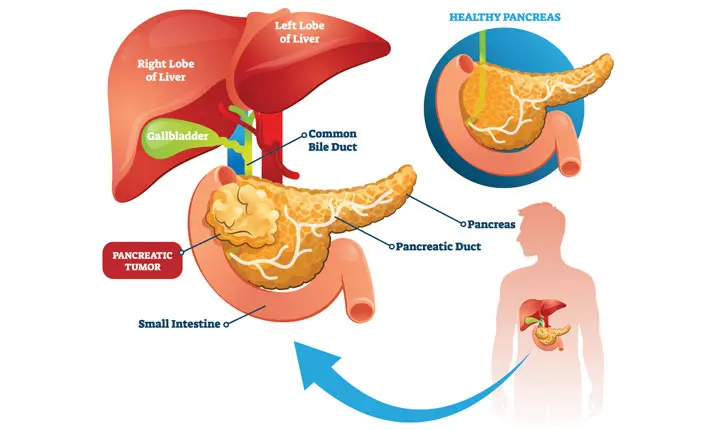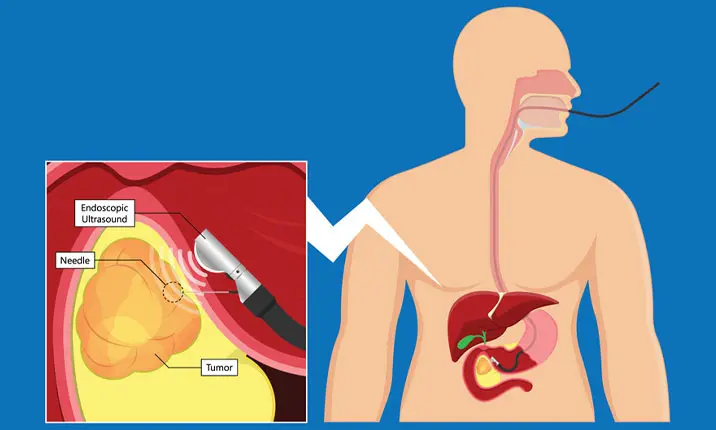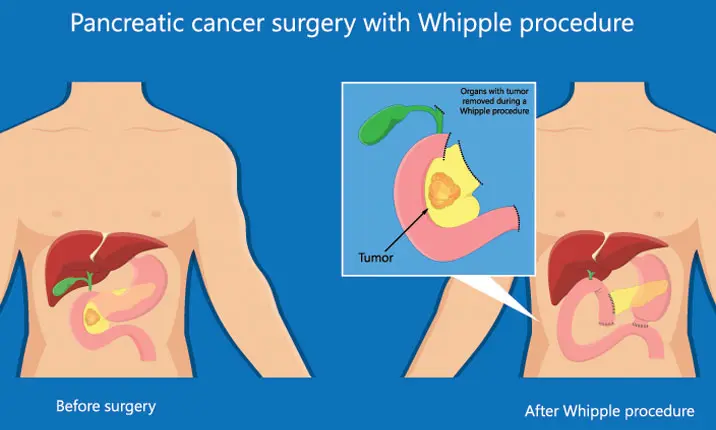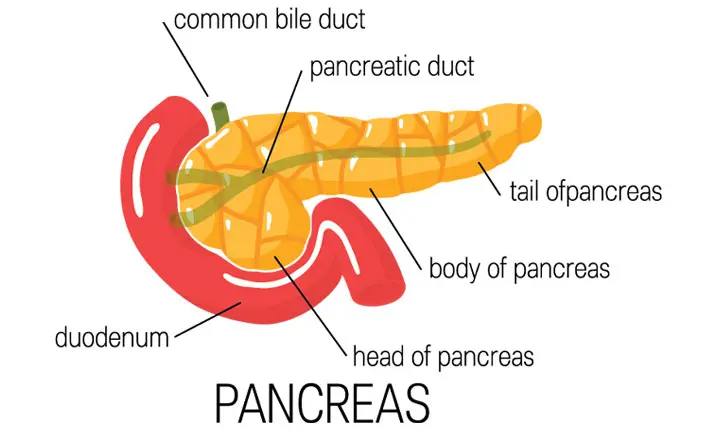Dr Tan Yu-Meng, general surgeon at Mount Elizabeth Hospital, gives us the facts about pancreatic cancer and the treatment options available for patients.
Individuals diagnosed with pancreatic cancer face a stark reality – only about 5% of people diagnosed with pancreatic cancer survive for 5 years or longer, with just 1% surviving for 10 years or more after being diagnosed.
The majority of patients with pancreatic cancer progress to locally advanced or metastatic disease (cancer that has spread to other parts of the body) in the phase when there are no symptoms yet.
Surgery is the only definitive treatment with a 5-year survival rate (after successful resection) of 20 – 25%. However, this is usually only possible in 20 – 25% of patients by the time they are diagnosed.
What is pancreatic cancer?
Pancreatic cancer occurs in the tissues of the pancreas. The pancreas is an organ in the abdomen that is located behind the lower part of the stomach. It functions to release enzymes that help with digestion and produce hormones to manage blood sugar.
Growths that happen in the pancreas can be cancerous or non-cancerous tumours. The most common type of pancreatic cancer is known as pancreatic ductal adenocarcinoma. It begins in the cells that line the ducts that carry digestive enzymes out of the pancreas.
Detection of pancreatic cancer is often late as no symptoms are seen until the later stage of the disease when it has spread to other organs.
Signs and symptoms of pancreatic cancer
Signs and symptoms of pancreatic cancer are only seen when the disease is advanced. They may include:
- Abdominal pain that shoots to the back
- Loss of appetite and unintended weight loss
- Jaundice – yellowing of the skin and whites of the eyes
- Light-coloured stools
- Dark-coloured urine
- Itchy skin
- A new diagnosis of diabetes or existing diabetes that becomes difficult to control
- Blood clots
- Fatigue
Causes of pancreatic cancer
The cause of pancreatic cancer is still not clear. The cancer occurs when cells in the pancreas develop changes (mutations) in their DNA. These mutations tell the cells to grow uncontrollably and to continue living after normal cells would die.
As the cells grow and continue living, they accumulate and can form a tumour. When left untreated, the pancreatic cancer cells can spread to other parts of the body.
Who is at risk of developing pancreatic cancer?
The opportunity to detect and treat pancreatic cancer successfully depends on the ability to identify and screen high risk populations before symptoms arise.
Family history of pancreatic cancer. The vast majority of pancreatic cancer occurs due to sporadically occurring mutations with less than 10% due to inherited or familial genetic mutations. These at-risk groups should be screened for pancreatic cancer.
Among the other 90% of patients who develop pancreatic cancer, a recent analysis of 117 studies1 identified the main risk factors that can be modified. They include:
- Tobacco
- Helicobacter pylori infection
- Recent onset diabetes
- Factors related to dietary habits (a BMI above 30, high red meat intake, low fruit and vegetable intake)
This presents a unique opportunity to educate the public on lifestyle-related modifiable risk factors to reduce or prevent one of the most lethal cancers.
This presents a unique opportunity to educate the public on lifestyle-related modifiable risk factors to reduce or prevent one of the most lethal cancers.
How is pancreatic cancer diagnosed?
The early symptoms of pancreatic cancer are related to the mass effect of the tumour.
Two-thirds of pancreatic cancers arise in the head of the pancreas and the remaining one-third in the body and tail.
Tumours of the body and tail tend to only show symptoms at a more advanced stage than tumours in the head which can obstruct the bile duct or pancreatic duct earlier on.
As such, obstructive jaundice, weight loss, non-specific abdominal bloat and pain, steatorrhea and early onset diarrhea are the most common symptoms.
Imaging remains the best way to diagnose pancreatic cancer.
CT Scan
A triphasic fine cut computed tomography (CT) scan is the best way to detect a pancreatic cancer. This also allows for the surgeon to assess if the mass can be removed by surgery as the portal vein and mesenteric artery can be well-visualised, and lymph nodes and peritoneal involvement can also be assessed.
The MRI scan offers no significant advantage except in patients with cystic neoplasms of the pancreas.
What is the role of biopsy in pancreatic cancer?
The gold standard for diagnosis of pancreatic cancer is a definitive biopsy but this may not always be possible or necessary. However, in borderline or doubtful cases it is necessary to perform a biopsy before surgery or treatment.
Endoscopic ultrasound (EUS)
Endoscopic ultrasound (EUS) has become increasingly popular as a tool to image and obtain tissue biopsy in resectable (surgically-removable) pancreatic cancer.
There is some concern that this may lead to tumour cell spread but more recent studies show that this may be carried out without consequence on survival after surgery.
Percutaneous biopsy
Percutaneous biopsy is not advisable in potentially resectable cases and should not be performed.
What are the current treatment options?
Managing pancreatic cancer often requires the combined opinion of a multidisciplinary team which would include a pancreatic surgeon, medical oncologist and gastroenterologist.
The main goal is to eliminate the cancer if possible. When this is not an option, the focus is to prevent cancer growth. In advanced cases where treatment is unlikely to offer a survival benefit, the main goal should be to ensure the best possible quality of life for the patient.
Surgery
Only 25% of pancreatic tumours are deemed resectable (possible to be removed surgically) at diagnosis. The main goal of surgery should be to surgically remove the entire tumour as well as a margin of tissues surrounding it. If the surgeon deems this possible, upfront surgery remains the standard of care.
Whipple procedure (pancreaticoduodenectomy)
For tumours in the pancreatic head, an operation called the Whipple procedure (pancreaticoduodenectomy) is the procedure of choice. This involves removal of the head of the pancreas, the duodenum, gall bladder and part of the bile duct.
Distal or subtotal pancretectomy
For tumours in the body and tail, a distal or subtotal pancretectomy is required. Both these surgeries should be carried out by surgeons who are experienced in pancreatic cancer surgery. This results in lower risk of disease/death from these challenging operations as well as better long term survival.
Both these surgeries can now be performed by minimally invasive techniques which can result in lower risk without having a negative impact on cancer outcome. This option is not widely available at present but will likely become standard of care in the near future.
Chemotherapy and radiation therapy
There are 3 main roles for chemotherapy and radiation in pancreatic cancer treatment.
Firstly, this can be used in patients with borderline resectable tumours to shrink the tumour and select good patient responders for surgery. Close communication between surgeon and oncologist is essential to plan and manage such patients.
Secondly, it also plays a major role in an adjuvant (support after the initial treatment) setting after successful surgery.
The largest group of patients with pancreatic cancer have locally advanced disease where surgery is not possible.
Here, there is also a role for chemotherapy to prolong survival by controlling the spread and growth of the primary tumour. There are multiple chemotherapy regimens which have been proposed as well as clinical trials. Patients should discuss with their oncologist on the regimen that best suits them.
Palliative treatment for metastatic pancreatic cancer
Patients with metastatic cancer (cancer which has spread) makes up 30 – 40% of patients diagnosed.
Surgery and endoscopic stenting techniques play a major role in the relief of biliary and duodenal obstruction. These are often required before starting chemotherapy in patients for metastatic disease.
The patients are also often malnourished, and effort should be made to address the nutritional aspects of advanced pancreatic cancer.
Pain control is another important aspect of palliative treatment.
Consulting a pain specialist is often helpful. There has been a significant effort placed in finding the best combination of chemotherapy and targeted therapy agents for treatment of this group of patients.
What next in pancreatic cancer treatment?
Pancreatic cancer remains one of the most difficult cancers to cure. Over the last few years, there has been an intensive effort made to identify common genetic abnormalities which can be used as targets in pancreatic cancer.
However, pancreatic cancer has been shown to be an extremely diverse disease and this gives rise to major challenges in identifying suitable targets.
The stark reality is that cure remains elusive in the treatment of pancreatic cancer. However, a good quality of life and longer survival is achievable in the large majority of patients.

















